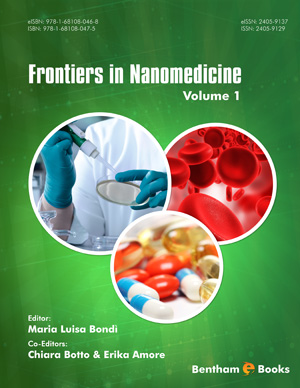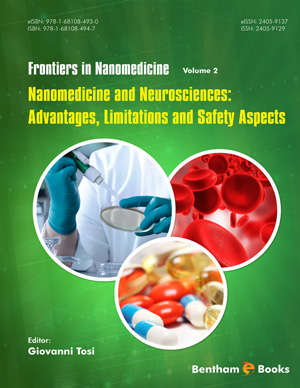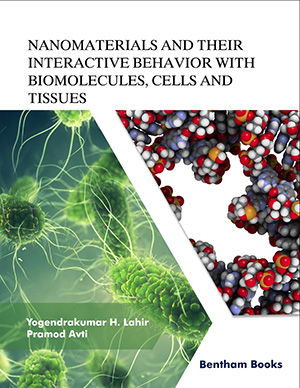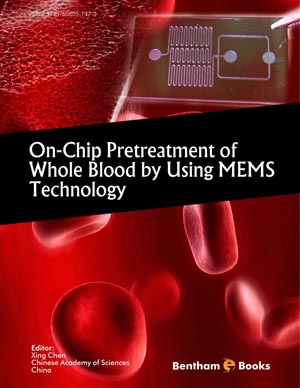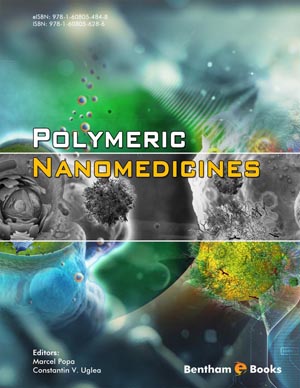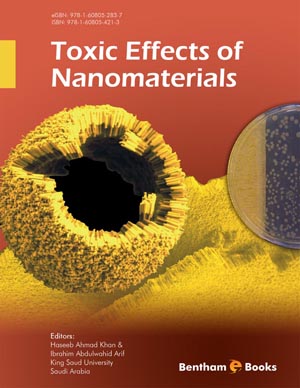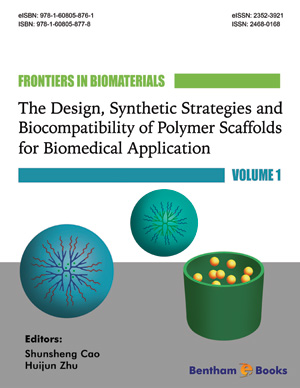Preface
Page: i-ii (2)
Author: Shahid Ali Khan, Saad Salman and Youssef O. Al-Ghamdi
DOI: 10.2174/9789815036725121010001
Nanotherapeutics for Treatment of Neurological Disorders
Page: 1-15 (15)
Author: Phoebe Wilson*
DOI: 10.2174/9789815036725121010004
PDF Price: $15
Abstract
Our brains are undisputedly regarded as one of the most complex biological structures, therefore it is not surprising that there are challenges associated with the transportation of therapeutic agents across this organ. This may be attributed in large part to the blood-brain barrier (BBB), which maintains a very stable environment in order to sustain normal brain function. The blood-brain barrier is comprised of a highly selective semipermeable border of epithelial cells that shield the brain from unwelcome and invasive substances. It is so effective, however, that it impedes the transportation of drug delivery used to treat various neurological and cerebrovascular disorders, such as Parkinson’s Disease (PD), Alzheimer’s Disease (AD), stroke, and gliomas (tumors in the brain and spinal cord). Consequently, many central nervous system disorders are undertreated. Significant advances in nanotechnology have increased the feasibility for biomedical applications to the brain, as nanopharmaceuticals may be tailored with functional modalities that assist to target selective brain tissue.
Molecular Mechanism of Therapeutic Actions of Some Nanoparticles in Some Diseases
Page: 16-71 (56)
Author: Bello Aminu Bello*, Ibrahim Khalil Adam, Sani S. Usman, Yahaya Saidu Gwarzo, Luqman Shah and Fatima Sulaiman Abdullahi
DOI: 10.2174/9789815036725121010005
PDF Price: $15
Abstract
This chapter covers a detailed description of various molecular mechanisms of therapeutic actions of silver nanoparticles (AgNPs), gold nanoparticles (AuNPs), Iron Oxide nanoparticles (FeO-NPs), Titanium Dioxide nanoparticles (TiO2-NPs), Cerium Oxide Nanoparticles (CNPs), Zinc Oxide nanoparticles (ZnO-NPs), Nitric oxide releasing nanoparticles (NO-NPs) among others in cancer, diabetes, bacterial, fungal, viral and inflammatory diseases. The mechanisms of anticancer activity of the nanoparticles (NPs) range from ultra-structure disruption, generation of reactive oxygen species (ROS), induction of DNA damage, inactivation of proteins that regulate signalling pathways, inhibition of migration and angiogenesis as well as induction of apoptosis. The mechanism of anti-diabetic activity of the NPs is through inhibition of α-amylase and protein tyrosine phosphatase 1B. The antibacterial and anti-fungal activities of the NPs are by disruption of membrane and induced DNA damage as a result of generation of ROS and dissolved metal ions. The diseases associated with viral infections are treated by restricting the entrance of the virus into the host and by binding to the ap120 site on the viral membrane, thereby regulating its function. The therapeutic mechanism of the NPs in inflammatory diseases is through blocking the production of pro-inflammatory cytokines, inhibiting mast cell proliferation, suppressing lipopolysaccharides (LPS) induced cyclooxygenase (COX-2) gene expression, reducing vascular endothelial growth factor level, decreasing Hypoxia- Inducible Factor (HIF) 1 α -gene expression, suppressing the inducible nitric oxide synthases (INO) gene expression as well as preventing mucin hypersecretion. Therefore, it is clear that the NPs possess various effective and efficient mechanisms of action against both infectious and degenerative diseases.
Nanotherapeutics for the Treatment of Voltage Gated Ion Channels
Page: 72-91 (20)
Author: Fahad Hassan Shah, Song Ja Kim*, Muniba Tariq, Sifeng Lucy Chen, Zunaira Afzal, Maham Chaudry, Saad Salman, Hassan A. Hemeg and Shahid Ali Khan
DOI: 10.2174/9789815036725121010006
PDF Price: $15
Abstract
Nanomedicine is the best way to deliver the plant bioactive to the targeted site. To deliver the plant bioactive in such a small range (10-9) prevents it from many problems like toxicity, less solubility, low permeation through membrane bilayer as well as enhancing the therapeutic activity and bioavailability of the plant drug. Nanotechnologies like liposomes, emulsions, nanoparticles, and hydrogels are proven to transport the plant extracts at the site of action and enhanced their efficacy and efficiency. Nanotechnologies have shown a new picture to achieve the best advantage out of the plant extracts and are serving in the fields of medical, cosmetics, and pharmaceutics.
Stimuli Responsive Hydrogels Composites for Control Drug Delivery
Page: 92-112 (21)
Author: Zubair Ahmad, Shahid Ali Khan*, Youssef O. Al-Ghamdi, Waseeq Ur Rehman, Syed Muhammad Mukarram Shah, Yasir Anwar, Noureen Khan and Saad Salman
DOI: 10.2174/9789815036725121010007
PDF Price: $15
Abstract
Drug loaded on the injectable polymer hydrogels to reach safely to the targeted site and elute slowly has significant advantages. For this purpose, many techniques have developed for crosslinking (CL) of the polymers chain including physical and chemical CL. Chemical CL (covalent CL) is more effective approach because it provides significant mechanical strength as compared to physically crosslinked hydrogel. There are a number of factors including light, pH, electric current, and glucose are used to stimulate the loaded drug release. For this purpose, various modifications have been made in the hydrogels by changing the CL strategies. In this chapter, a variety of CL techniques have been described along with its advantages and limitations including physically CL, chemically CL, hydrogen-bonding interaction etc. Moreover, the response of hydrogels to different stimuli in environment like temperature, pH, electric current, light and glucose sensitivity are also explained with few examples reported in the previous literature. Composite materials (CT) is one of the most emerging materials in various scientific and technological sectors and are effective in various biological applications. Therefore, the CT based hydrogels, are also included in the discussion of this chapter. The role of dexamethasone, methylene blue and vitamin B12 loading and release via CT based hydrogel are described in this chapter.
Polymeric Nanofibers for Wound Dressing Applications
Page: 113-141 (29)
Author: Abid Mehmood Yousaf*, Yasser Shahzad, Fakhar Ud Din, Qurrat ul Ain Yousafi, Talib Hussain, Muhammad Usman Ghori and Syed A. A. Rizvi
DOI: 10.2174/9789815036725121010008
PDF Price: $15
Abstract
The broken, ripped or crumbled area of the skin occurr due to laceration, abrasion, incision or excision is called a wound. Speedy and proper wound healing is very important for all types of wounds in order to restore the cosmetic appearance of the skin. Wound healing process is a dynamic and intricate cascade of different steps, including the initiation and termination of numerous cellular mediators. A wound dressing is a germ-free patch or mat placed at the wound site to expedite the healing process and protect the wound from further trauma and infection. A wound dressing patch or mat consisting of antimicrobial drug-loaded polymeric nanofibers (NFs) is an advanced type wound dressing which furnishes several benefits that are usually expected from an ideal wound dressing. Electrospinning methodology is a promising strategy to obtain antimicrobial drug-loaded polymeric nanofibers. Then, these nanofibers are characterized for the drug release, shape and surface quality, ability to endure mechanical shocks, antimicrobial activity, and in vivo wound healing effectiveness. Moreover, histopathological explorations might be accomplished in order to assess the actual progress of the healing process in the wound. In particular, the development of a wound dressing using antimicrobial drug-loaded electrospun polymeric NFs is an excellent approach to accomplish speedy healing of wounds and restoration of the skin.
Nano-therapeutics of Flavonoids-loaded Polymeric Drug Delivery Systems
Page: 142-160 (19)
Author: Fazle Rabbi*, Fahim Ullah Khan, Imad Ahmad and Amna Nisar
DOI: 10.2174/9789815036725121010009
PDF Price: $15
Abstract
Plant-based foods contain flavonoids, belonging to the polyphenols class. The phytochemical and phyto-pharmacological sciences advancement has enabled composition elucidation and biological activities of various medicinal plant products. The efficacy of medicinal plants can be measured on the basis of bio-active constituents they comprise. Flavonoid is one of the classes among the bio-active constituents that are hydrophilic in nature. They have low bioavailability and efficacy due to low absorption, as they cannot cross cells lipid membrane due to larger molecular size. A variety of novel drug delivery systems have been developed for polyphenolic compounds to enhance the relative bioavailability. However, if novel drug delivery technology is applied, it may reduce the adverse effects and increase the efficacy of several herbs and their compounds. Herbal medicines were not encouraged for novel formulations development for a long time due to lack of scientific justification and processing difficulties, such as individual drug components identification, extraction and standardization in complex poly-herbal systems. However, advance phytopharmaceutical research can reduce the scientific thirst (e.g, pharmacokinetics determination, mechanism of action, the accurate dose required, site of action etc.) for herbal medicines to be incorporated in novel drug delivery systems, such as nanoparticles (NPs), liposomes, matrix systems, and micro-emulsions (-E) etc. by improving activity by reducing the side effects and required dose. Various drug delivery technologies have been summarized in this chapter which can be used for flavonoids loaded polymeric drug delivery systems.
ADHD Comorbid to Substance Use Disorder: A Review of Genetics, Neurobiology, Brain Circuitry, and Nanotherapeutics
Page: 161-206 (46)
Author: Fahad Hassan Shah, Song Ja Kim*, Laiba Wasim, Shanza Nageen, Fakhra Sibtain, Muniba Tariq, Sajid Asghar and Saad Salman*
DOI: 10.2174/9789815036725121010010
PDF Price: $15
Abstract
In this chapter, the relationship of neurobiology and brain circuitry of attention deficit hyperactivity disorder (ADHD) and substance use disorder (SUD) along with the heroin addiction (HD) screening similar genetic was examined. The exacerbation of symptoms of SUD and ADHD is also allied with familial and environmental impressions. High-risk factors of ADHD were repeatedly found amid the kinspersons of ADHD descendants. Family and twin studies suggest that genetic and environmental factors have a great influence accounted for about 70-80% of inheritance. Children of SUD and HD parents showed a high rate of ADHD or vice versa. Smoking during pregnancy is deliberated to be the prevalent risk for expansion of ADHD. SUD in offspring of parents with the same disorder is validated by many studies that recognized the psychopathology and association of affected parents with their children. The chances of developing ADHD in offspring of those parents who are addicted to heroin are at three times and that of SUD are about sixteen times elevated rates than those having parents with controlled demographic characteristics and proband’s comorbidity. The drug purification and withdrawal of SUD often simulate the symptoms of ADHD. The relationship between ADHD and SUD is somewhat complex and multi-faceted. Neuroadaptation in reward and stress pre-dispose an individual to SUD, ADHD, or both are altered. However, a deeper understanding of an alteration in the development of the cortico-cortical and sub-cortical network as ADHD progresses would help in deciding whether dysfunctions of the brain network are the main cause in the pathophysiology of ADHD. Future studies should be more oriented towards the association between cortical, subcortical regions and more resources should be used. The basic action of the herb is to treat the physiological, neurological, and performance parameters. These actions cover the people who are suffering from ADHD and many herbal medicines were used to recognize the stimulant actions. The fresh leaves are usually used for performing different activities like anti-spasmodic activity as well as a nutritive nerve tonic. Sedative and stimulating herbs in different combinations are generally used in naturopathic and also in the herbal practice to cure ADHD. The investigation of different stimulants and activities of the herb is used to check the motor functions and performance in the anxiety and anxiety-related disorders’ treatment modalities.
Sodium Channelopathies and Novel Viral/non-viral Vectors for their Gene Therapy
Page: 207-231 (25)
Author: Jawaria Idrees, Fahad Hassan Shah, Song Ja Kim, Muniba Tariq, Syed Haroon Khalid, Ikram Ullah Khan, Sajid Asghar and Saad Salman*
DOI: 10.2174/9789815036725121010011
PDF Price: $15
Abstract
Channelopathies are a group of neurological disorders that is caused by various genetic or acquired factors. In this disease, ions channels, a transmembrane protein channel responsible for the regulation of electrochemical gradient in the neuronal cells are disrupted. The disruption leads to myriads of neurological havoc due to abrupt synaptic transmission, voltage potential, and hyperexcitability of ions channels. Defective ions channels expedite the development of various disorders i.e., migraine, epilepsy, small fiber neuropathy, erthemalgia, paroxysmal pain disorder, dravet syndrome, and congenital insensitivity to pain, and others. These defects are commonly caused by deleterious mutational events in the ion channel gene encoding regions (SCN9A, SCN10A, and SCN11A). These regions encode for alpha subunits of sodium voltage gated channels (NaV 1.7, 1.8, and 1.9) that have notable importance in normal neuronal functioning. In these regions, usually, missense mutations are observed that cause improper protein folding making sodium channels excited for longer periods. The excitation is mainly manifested in peripheral and sympathetic neurons that contribute towards the development of chronic or acute pain or no pain sensation at all. There are several studies in the pipeline trying to elucidate the molecular mechanism of pain in relation to channelopathies. The lack of efficient pain models and shortcomings in the ill elucidate nature of the disease is somehow impeding the progress and development of novel therapies. But the existing literature revealed various pathways and targets that could be fruitful for different gene therapy interventions as opioids, analgesics, and non-steroidal anti-inflammatory drugs used to treat these conditions are imposing significant side effects and cellular proteins are developing resistance for these molecules, hence making them obsolete.
Gene Therapy and Editing for the Treatment of Single-Gene Pain Disorders
Page: 232-260 (29)
Author: Fahad Hassan Shah, Song Ja Kim*, Jawaria Idrees, Muniba Tariq, Syed Haroon Khalid, Ikram Ullah Khan, Sajid Asghar and Saad Salman*
DOI: 10.2174/9789815036725121010012
PDF Price: $15
Abstract
It is a well-known reality that genetic variants can alter the pain perception of an individual in correlation with painless and painful voltage-gated Nachannelopathies for the better understanding of molecular transmission and detection events to noxious stimuli. Mutations in Nav 1.7 gene coding for the Na-ion channel can cause severe syndromes of distinctive pain such as small-fiber neuropathy, inherited erythromelalgia, and paroxysmal pain disorder. Whereas the inactivation of SCN9A mutations that encodes Nav 1.7, as a consequence, leads to insensitivity to pain congenitally. The TRPA1 heterozygous mutations code for Nav1.9 (SCN11A) and Nav1.8 (SCN10A) can cause insensitivity to pain while other variants are responsible for the potential-cation channel of the transient-receptor which can cause episodes of familial pain syndromes. Moreover, recently found few other novel genetic polymorphisms essentially identify the severity and complexity of the pain phenotypes. Various pain models for a better understanding of the sensory disorders and heritable disorders of pain are in the developmental phase. Therefore, devising new therapeutic approaches, genome-guided therapy, and understanding the structure of receptors for novel drug development and delivery in correlation with Na-ion channel is imminent.
Introduction
Advances in technology have enabled medicinal chemists to discover and formulate several highly specific, biocompatible, and non-toxic therapeutic agents for clinical applications. Nanotechnology has achieved significant progress in the last few decades and is crucial in every field of science and technology. Nanotechnology-based pharmaceuticals offer multifaceted and alternative methodologies in comparison to the limitations of many conventional clinical therapies. Expertise in designing and developing nanoformulations has helped in targeted drug delivery. Recently, the use of innovative therapeutic agents, particularly in nanomedicine, has accounted for a significant portion of the global pharmaceutical market and is predicted to continue to grow rapidly in the near future. Nanotherapeutic Strategies and New Pharmaceuticals is an accessible multi-part reference which informs the reader about several new techniques based on nanotechnology. The chapters explain relevant topics in detail. The book is designed to encourage and help undergraduate, graduate and post-graduate students in the field of nanotherapeutics, pharmaceuticals and bio-organic chemistry through the use of didactic language and simple illustrations. Part 2 of this book covers the potential of nanotherapeutics and natural therapies for treating neurological diseases, targeting ion channels, signal transduction therapy, gene therapy of single gene mutation diseases and for nanoformulations for special purposes such as wound healing and stimuli-responsive drug delivery. The book also features a chapter that summarizes the types of nanoparticles tailored for specific molecular targets that mediate different diseases. The book set serves as a textbook for students in pharmacology and medical biochemistry, as well as a quick reference for researchers on bio-organic chemistry, as well as general readers interested in nanomedicine.




